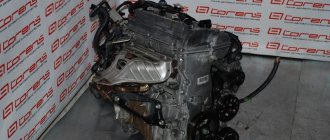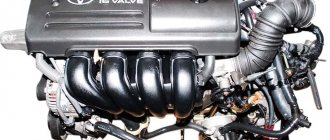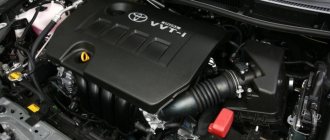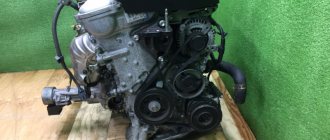The AZ series has become an excellent replacement for S category engines. The AZ collection of the largest Japanese automaker includes in-line four-cylinder gasoline engines. This product includes an aluminum cylinder head with special camshafts and an aluminum engine block made of cast iron cylinder lenses.
A distinctive feature of this series of engines was the use of the latest engineering technologies (for example, inclined combustion chambers of the “squish” type with mixed centers of the crankshaft and cylinders). It is also worth noting that the steel crankshaft is equipped with five high-quality bearings and eight main counterweights, which ensures the balance and stability of the entire mechanism. The 2AZ-FE engine itself has the following parameters: 62.6 * 60.8 * 68.1 centimeters. New engines of the AR series brand are now being actively distributed.
Technical parameters of Toyota 2AZ-FE engines
The main technical characteristics of this modification of motors include:
- Number of cylinders – 4.
- Number of valves – 16.
- The highest power rating is 160 horsepower.
- Volume – 2.4 liters.
- The moment of force – at 400 revolutions is equal to 220 N*m.
- The cylinder diameter is 8.85 centimeters.
- The piston stroke is 9.6 centimeters.
- The compression ratio is 9.1 to 1.
- Knock resistance of fuel (octane rating of gasoline) – from 95.
Due to the versatility of the above technical characteristics of the motor, this mechanism is widely used in vehicles of different price categories. However, the constant development of modern technologies has significantly reduced the authority of the 2AZ-FE series engines around the world. The main technical and operational advantages of engines undoubtedly include: a large number of technical innovations, economical fuel consumption, and simplicity of design. The disadvantage is the expensive and often difficult repair of the unit.
FXE – motor resource advantages and disadvantages
The lightweight and durable engine of the 2AZ-FXE series began to appear in the Toyota car line since 2000. It became a replacement for the already well-worn 5S series, and spent almost 10 years on the assembly line in mass production.
The design, traditional for this time of development, and rather complex electronics made the motors quite reliable, but added a number of disadvantages. However, the main advantage of this power unit is that the engines last 300,000 km without problems; in a number of cars, a mileage of 400,000 km was recorded.
This is what the 2AZ-FCE engine looks like
It is simple and easy to maintain, suitable for use in harsh climatic conditions, unpretentious and reliable. But, there are a number of disadvantages that are worth mentioning:
- Before 2007, there was a coolant leak due to the threads of the cylinder head bolts breaking
- Motors after 2007 usually suffer from progressive oil burns
- Throttle valve contamination is the main cause of floating speed
- The life of the pump often does not exceed 50,000 km; after 150,000 km the chain stretches
- A recall was issued in 2010 due to possible fuel leakage in the event of an accident.
In any case, the 2AZ-FXE is a worthy engine that is loved by domestic motorists.
Technical parameters of 2AZ-FSE engines
The main technical characteristics of motors in this series include:
- Volume – 2.4 liters.
- The highest power rating is 163 horsepower.
- The cylinder diameter is 8.9 centimeters.
- Engine type – chain drive with gasoline fuel.
- Fuel consumption per 100 kilometers is 9.5 liters.
- Compression value – 11.
- The piston stroke is 9.6 centimeters.
- There is no start-stop mechanism.
Difference between Toyota 2AZ engine models
- the first basic modification of the engine with a compression ratio of 9.6 is 2AZ-FE. This device has a maximum power of 160 horsepower. At the end of 2008, the engine design underwent significant changes - the camshafts were replaced, due to which the compression value increased to 9.6 and power to 166 horsepower;
- the second model of the 2AZ-FSE engine is equipped with an instantaneous fuel injection system, the compression value is 11, and the power is 163 horsepower. To date, the production of the unit has been completed;
- the third model in this series, a hybrid engine based on the Atkinson principle - 2AZ-FXE. Compared to previous versions, the engine has a modified camshaft design and a high compression ratio (12.5), and the engine power is 130 or 150 horsepower.
Engine maintenance schedule
Car owners are advised to strictly follow the engine maintenance instructions for the 2AZ FE model. Without this, the engine will reduce its lifespan significantly, and if the car owner’s driving style is erratic, with constant acceleration, high speed development and sudden stops, then the unit will not last even 150,000 km.
The service regulations at the service center include:
- change the lubricant every 5 thousand kilometers, although the manufacturer advises replacing it after 10 thousand. Oil should be filled with 5W30, 5W20. Buy only at specialized car markets. To replace, you will need about 4.3 liters, and the total volume of the oil tank is 5 liters;
- experienced mechanics recommend inspecting the chain for chips and cracks every 40 thousand km, and replacement after 120,000;
- thermal clearances are adjusted after 100 thousand km by selecting pushers;
- a new air filter and fuel filter device are installed after 40 thousand kilometers;
- antifreeze is added after 5 years if the car is stationary, and during operation - after 80 thousand km.
By following the rules described above, the engine life can be increased to half a million kilometers. The unit is suitable for car owners with a relaxed driving style.
What is the difference between FSE and FE engine modifications?
Experts include the following differences between the FSE and FE motors:
- high pressure fuel pump for diesel engines. The pressure of a mechanical pump can reach 120 bar (typical for diesel engines). The pressure of the electric pump (for injection engines) is about 3 bar;
- engine injector. Vortex injectors can create different shapes of the fuel torch depending on the operating mode of the engine: in power mode - a conical shape, in lean mixture combustion mode - a narrow cylindrical shape;
- functioning of the engine piston. There is a special hole at the base of the unit, through which the direction of the air-fuel mixture is determined towards the spark plug;
- engine intake system. The FSE model is equipped with vertical intake channels - they create a “reverse vortex” in the cylinder, determining the direction of the air-fuel mixture to the combustion plug (standard engines have the opposite direction of the vortex in the cylinder);
- throttle operating on the principle of electronic control. Thus, the motorist does not control the operation of the damper; its operation is carried out using the accelerator pedal position sensor. The electric control unit then operates the throttle valve via an electric motor. Such a mechanism takes a heavy toll on the car owner’s wallet.
Disadvantages of engines
Most car owners who have encountered the operation of the 2AZ-FE engine note rapid overheating of the device during long trips. This unit is not intended for long-term driving at high speeds. Drivers cite expensive maintenance and repairs as another significant disadvantage of the mechanism (for example, if the rings are stuck, a complete replacement of all cylinders is necessary). The plastic intake manifold is also characterized by poor reliability.
One of the most important disadvantages of this unit is the lack of repair parameters. This situation leads to the fact that when individual engine parts depreciate (often due to long-term operation or the use of low-quality fuel), a complete replacement of the unit is necessary. This is due to the fact that the thin-walled cylindrical block is not intended for the use of repair components. To avoid this problem, many drivers use contract engines.
Why does he “rip his head off”?
The cylinder head of the 2AZ-FE engine is very thermally loaded and under high load on the engine (driving in traffic jams in the summer, a long climb uphill in the heat), it overheats, which leads to deformation. As they say, the cylinder head “becomes a house.” The tightness of the cylinder head and its gasket to the block is broken. In this case, antifreeze instantly breaks through into the cylinders from the open cooling jacket of the block. On the contrary, gases from the cylinders rush into the cooling system: “gases” appear in the expansion tank and steam appears from the exhaust pipe.
And when unscrewing the cylinder head bolts of the 2AZ-FE engine, some give in without any effort at all. This means that the bolts have “moved away”, because the threads in the aluminum block simply broke off. Usually the threads of the bolts securing the cylinder head in the middle break off.
Of course, this complicates repairs and increases costs. You have to cut a new thread or insert threaded bushings (screws) and “screw them” to them.
The problem was recognized by Toyota. Quite a few 2AZ-FE engine blocks were replaced under warranty.
Since 2006, the production of modernized blocks with optimized circulation of coolant in its upper part began.
Gas distribution mechanism of the drive
The timing drive refers to a sixteen-valve DOHC, the power drive is carried out through a single-row roller chain. The chain tension is carried out using a specialized hydraulic tensioner, and lubrication is carried out with an oil-type nozzle.
The intake camshaft is equipped with a VVT modification drive sensor (mechanism for determining valve timing periods), as well as a phase limit indicator of 50 degrees. The presence of a set of pushers allows you to adjust the clearance in the valve drive. This prevents drivers from having to make expensive and difficult mechanical adjustments.
Chain wear resistance is a rather unpredictable parameter. It is almost impossible to predict when the life of the chain will end - it can be either 300,000 or 150,000 kilometers. Chain wear is reflected by unpleasant noise during operation and defects in valve timing. Experienced motorists recommend a complete replacement of the chain and all drive components, since old working parts lead to “obsolescence” of the repaired or new chain. However, not all drivers adhere to this advice, because the intake camshaft sprocket is included in the VVT drive kit. The hydraulic tensioner of the system requires timely repair, but this is the fastest and most inexpensive process.
Problems in maintenance and operation of 2.4 liter Toyota internal combustion engines
If we summarize all of the above, then in addition to the positive qualities, engines from the 2AZ series also have their dark side:
- Short pump life (leakage can occur after 50 thousand kilometers);
- Unstable operation due to contamination of the throttle valve;
- The need to periodically check and adjust the valve clearance (the procedure is very complex and expensive).
- The proprietary direct fuel injection system is sensitive to the quality of gasoline and others.
In most cases, all these problems begin to appear after 250 thousand kilometers or after 5 - 6 years of operation. Therefore, when buying a used car with an engine of this series, we strongly recommend that you pay attention to this.
What do drivers think of the engine?
In summer, fuel consumption is about ten liters, but in winter it can reach twelve liters. About three hundred milliliters of oil are consumed per ten thousand kilometers - this is despite the fact that the engine is used in urban conditions when driving at high speeds. Some drivers note that oil consumption for Toyota engines is slightly too high.
We bring to your attention the price list for the contract engine (without mileage in the Russian Federation) 2AZ-FE
Price list
Repair and service
Maintenance of the Toyota 2AZ-FE power unit consists of timely replacement of consumables.
It is recommended to change the engine oil and oil filter at least every ten thousand kilometers.
The oil pump is located in the crankcase and is driven by an additional chain.
Adjusting valves on 2AZ is not a simple operation. Not every service will undertake such work, and where they do it correctly, they will ask for quite a small amount. Therefore, owners often neglect this procedure.
If excessive vibration occurs and the smooth operation of the 2AZ-FE engine is disrupted, you will need to check the condition of the balancing shafts. They are located in the engine crankcase.
Repairing a 2AZ-FE series engine requires significant investment. When observing wear and tear on individual engine elements, engine capital repairs involve a complete replacement of the power unit. Many car owners solve the problem by purchasing a contract 2AZ-FE engine.
Replacing the timing chain
The timing chain on the 2AZ-FE power unit is replaced as the main elements included in the gas distribution mechanism wear out. The cost of the original repair kit is very high, so it is more rational to use analog options. Their price can range from 3,500 to 10,000 rubles. Produced by the Japanese company OSK. You will also need to purchase engine oil, an oil filter and sealant. The purchase of these materials will cost three thousand rubles. When replacing the timing chain in service centers, the cost of the work will be about 12,000 rubles.
Hydraulic chain tensioner AZ. Image by toyota-club.net
When replacing the timing chain, it is necessary to match all the marks provided in the 2AZ-FE engine. With their help, the following elements are set in relation to each other:
- crankshaft pulley with a zero mark on the frontal part;
- camshaft sprockets with camshaft bearing caps;
- intake and exhaust camshaft sprockets.










